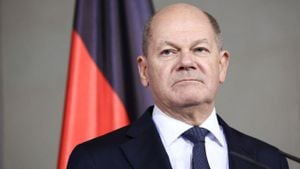A significant drone assault on Ukraine on February 23, 2025, has sent shockwaves through global markets, intensifying already rising tensions surrounding the continuing conflict between Ukraine and Russia. This military action not only adds to the chaos on the ground but also spurs fears and reactions among investors, with economists warning of the possible ramifications for market stability.
According to financial analyst Jamie McGeever from Reuters, "The continuing conflict and this recent drone assault will likely escalate tensions and affect market stability." This sentiment reflects the urgency felt on the trading floors globally as the news broke of drones being deployed in Ukraine, heightening concerns vividly displayed across stock markets.
The latest incident is merely one chapter in the long-running Ukraine conflict, which began back in 2014 but has recently escalated to alarming levels, as military actions have increased significantly. With each new development—be it troop movements, airstrikes, or drone assaults—the ripple effects are not limited to the battlefield; they extend to economies worldwide, sending investors scrambling for safer assets.
While the drone attack punctuates the grim realities of warfare, it also serves as yet another reminder of the interconnectedness of today’s global economy. Traders reacted swiftly; many turned to commodities like gold and energy stocks as safe havens. The financial markets have been sensitive to geopolitical developments, and this incident marked just another incident triggering widespread alarm.
Since the inception of the Ukraine conflict, international markets have fluctuated, with variations based on the nuances of conflict developments. On February 23, analysis suggested additional volatility could appear as events continue to unravel. Amidst shaky ground, investors are becoming increasingly cautious, apprehensive about what each news headline might mean for their portfolios.
Notably, even prior to the drone assault, markets had shown signs of nervousness. U.S. stocks had been feeling pressure amid fears of economic downturns and rising interest rates. With President Trump's administration facing criticism over tariffs and trade policies, even more uncertainty permeated the trading atmosphere. Now, with the new developments, the angst surrounding the stability of these markets has skyrocketed.
It is not just Wall Street feeling the effects; global indices are reflecting heightened nervousness. For example, reports of Japanese equity futures indicating anticipated declines highlight investor apprehension across continents. Analysts predict Asian markets could face downward pressure as awareness of the drone assault sinks in. The backdrop of already tenuous economic conditions makes any military escalations loom large over market sentiments.
Traders were seen pivoting investments toward risk-free assets like gold, which is considered one of the safest bets amid military conflicts. The demand for gold increased as it approached record highs, reminiscent of the protective trade habits often observed during periods of geopolitical instability. This week’s trading demonstrated gold began inching closer toward the $3,000-an-ounce threshold, reflecting the insecurities felt by traders.
Meanwhile, the U.S. dollar gained some strength as many worried about the fallout from the drone attack. Historically, the dollar has served as the world's premier reserve currency. Amidst fears surrounding international dependencies, it often responds to spikes of uncertainty with upward momentum.
Oil prices, too, were expected to react based on news flow from the Ukraine conflict. Historically, oil has seen volatility in response to geopolitical tensions. With Ukraine being central to energy exports and supplies, analysts speculated over how market sentiments would shift now. Crude oil prices have already shown declines of more than two percent on the expectation of continued conflict.
The overall sentiment paints murky waters for investors, who face the dual threat of political instability and economic turbulence. The question now balances on how deep the global markets could sink should conflict escalation become more pronounced. The potential for future drone assaults, air raids, and increased military readiness leaves investors uncertain.
It is precisely this uncertainty which not only clouds forecasts but also ensures global markets remain ever-leery of moves from factions within Ukraine and Russia. Investors draw on lessons from the past when international tensions have severely disrupted trading environments, and the fear around these markets only grows with headlines streaming from conflict zones.
Looking forward, the impact of events like these will remain at the forefront of investment strategies as the dynamics of military engagement intertwine with the world economy. Investors must keep their fingers on the pulse of international relations, as each successive drone strike or troop mobilization could lead to unforeseen shifts in the market framework.
All eyes are now fixed on Ukraine as not only the future of the nation hangs in the balance, but also the fates of economies worldwide. The situation remains fluid, and changes are imminent. Financial markets will continue to watch closely as reactions to such events forecast trends across industries.”}



